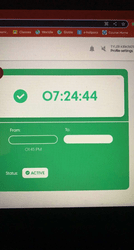New Tech at Talawanda
New Tech at Talawanda
By Eliza Sullivan
It’s been called “Big Brother,” “Orwellian,” and “a surveillance state.” What is it? It’s the new app being used at THS: eHallpass.
EHallpass is an app developed by Eduspire Solutions, who promise it will help limit “mischief, meetups, vaping, vandalism, and much more.” Students use their phone or chromebook to send a pass request to their teacher and can leave the classroom once the pass is approved. When they return to the classroom, the teacher cancels the pass.
According to Principle Davie, eHallpass is simply a more modern way to do hallpasses. He said it’s actually a way to save taxpayers money by using digital technology instead of buying paper planners for students. However, eHallpass didn’t eliminate the need for paper planners, given that many students use them to keep track of homework and the planners for this year were purchased before eHallpass was implemented.
EHallpass isn’t free, however. According to the Eduspire Solutions website, schools must pay $3.25 per student, plus a one-time implementation fee of $1,000. Given that Talawanda High School has more than 1,000 students, implementing eHallpass this year would have cost over $4,000. This cost was covered by a grant obtained by Officer Butler and Mrs. Macechko. That grant only covered the cost of one year of eHallpass, and in future years it will cost Talawanda more than $3,000 per year to continue buying access to the service.
So, how is eHallpass affecting Talawanda High School? Ms. Alfonsi, THS English Department Chair, said that eHallpass has helped students stay in their classrooms because both students and administrators are now aware of how often students are out of the classroom. She said there is definitely an adjustment period for both students and teachers when they use this technology. Remembering to end student’s passes is a struggle, she said, since she’s not always near her computer. Overall, however, Alfonsi has seen eHallpass create a positive impact on students. She said the more practice with and routines built around eHallpass, the easier it will be for everyone.
Senior class sentry Julio Fuentes said the student body seems to have some concerns about eHallpass. Many students feel that eHallpass is an invasion of privacy. They dislike administrators knowing how long they are places such as the bathroom or nurse’s office. Davie said that eHallpass isn’t invading student privacy at all. The only data that is put into the system is student name, school email, and school ID. He said that administrators can see passes, giving them the power to theoretically know how long students are in specific locations, but that in general, he and other administrators have no reason to look at specific passes. According to him, all eHallpass records are used for is verifying teacher’s reports of students that are frequently absent for long periods of time.
Students are also having technical difficulties with the eHallpass platform, said Fuentes. Many students have issues logging into the mobile app and say that the app will send them to the browser instead, which is an issue for students without mobile data. In addition, there is an issue with eHallpass’s “hallway traffic limit.” According to Davie, the hallway traffic limit is set at 15 students because that’s what eHallpass’s automatic recommendation was based on the size of Talawanda’s student body. This poses an issue for students, said Fuentes, who are often blocked from using the bathroom or going to get help during tutorial because the hallway traffic limit has been reached. Teachers can override this limit, but often don’t.
Fuentes said the opinions he’s heard of eHallpass from other students have generally been unfavorable. He personally thinks it could be useful for knowing where students are in emergency situations, but most students dislike it.
Principal Davie said it’s too early in the school year to know whether the school will implement eHallpass next year.

Photo: EHallPass for a student that was never ended by a teacher so it looks like the student was in the restroom for over 7 hours.


